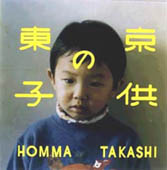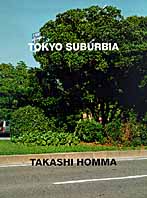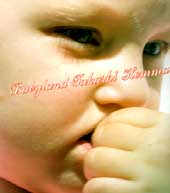HOMMA Takashi: Difference between revisions
(New page: HOMMA Takashi ホンマ タカシ (1962.8.23- ) Tokyo. Advertising and teen fashion photographer (Cutie magazine). Former mentor to HIROMIX. '''Career''' Family operated a camera shop i...) |
No edit summary |
||
| Line 123: | Line 123: | ||
[[Category:Japanese Photographers]] | [[Category:Japanese Photographers]] | ||
[[Category:Japanese photography]] | [[Category:Japanese photography]] | ||
[[Category:Japanese photobooks]] | |||
Latest revision as of 13:45, 24 January 2016
HOMMA Takashi ホンマ タカシ (1962.8.23- ) Tokyo.
Advertising and teen fashion photographer (Cutie magazine). Former mentor to HIROMIX.
Career Family operated a camera shop in Tanashi, Tokyo. Dropped out of Nihon Univ.'s photo dept. in 1985 and entered Light Publicity. Quit in 1991. Lived in London for a year from 1991 to 1992.
Issued photo book Babyland in 1995, Hyperballad: Icelandic Suburban Landscapes in 1997, Ura H Homma Camera in 1998, and Tokyo Suburbia in 1998 for which he won the 24th Kimura Ihee Award.
Awards 24th Kimura Ihe'e Award, 1998.
Book reviews below.
Tokyo Children (東京の子供)
 Portraits of children with a distant, impersonal gaze.
Portraits of children with a distant, impersonal gaze.
笑顔と温もりがない表情で撮った子供のポートレート集。でも怖がる必要はない。普通の子供は皆これらの表情をする。
Published: 2001-12-31
Publisher: Little More
ISBN: 4898150667
Price in Japan: ¥3,990
Qualities: Soft cover, color photos
Size: B4 square, 84 pp.
Language: Japanese and English
When we see pictures of children in the print media, we are used to seeing smiling faces, laughter, or crying faces. That's what makes most baby or kid photos look cute, interesting, or newsworthy. So when you see the portraits in this book, you might get a cold shiver from seeing their distant and impersonal faces.
But I didn't. I just see them as a fleeting moment in the child's diverse range of ever-changing emotions and inner states experienced every day. Just because a child is smiling now does not mean that he or she is a happy kid all the time. And vice versa, just because the kid looks aloof now does not mean he or she is psychologically off-balance or anti-social.
Photographs capture only one moment in time, not the entire story. So I would not conclude that these kids are mentally disturbed in any way just because of these portraits. You cannot draw any conclusions about any of these kids just by looking at these portraits. That's the big mistake Douglas Coupland has made in his nonsensical essay written for the book (and translated into Japanese which must have been really difficult). He is making conclusions about these kids and the future of the world based on these momentary, fleeting facial expressions which all kids have and have had since the birth of man.
I quote, "Looking into the eyes of the children photographed by Takashi Homma is a chilling look almost directly into the retinas of the next version of humanity--a phase so alien and different from our own, that it is nearly impossible to imagine both ourselves and these future mutations of ourselves existing simultaneously. At the very least these children are the next 'upgrade' of humanity."
The kids in fact all look perfectly normal. I have seen such distant gazes many times on children's faces. But you don't ever think to photograph it because you always want a smiling child's face instead.
Homma has done well in photographing the faces and moments which he wanted to capture. Children are always difficult to photograph in the way you want it. This series of photos matches his other work which also have a distant, detached, and dehumanizing feeling such as the huge housing complexes and carbon-copy detached houses in Tokyo Suburbia. You can see pretty much where he's coming from, and I have a hunch that he is drawing much on his own memories of growing up in a large, impersonal danchi (public apartment complex) for his photographic themes. (Reviewed by Philbert Ono) Reviewed on: 2002-05-19
New Tokyo Standard (ニュートーキョースタンダード)
 A mixture of teen fashion shots, suburbian landscapes, and urban development photos.
A mixture of teen fashion shots, suburbian landscapes, and urban development photos.
人物(モデルとかタレント)と都内の風景(お台場など)。パンフレットのような薄い本。写真のデータもある(英語!)。撮った年と場所とモデルの名前が分かる。写真集はこのようなデータがあった方が絶対いいです。
Published: 2001-12-01
Publisher: rockin' on
ISBN: 4947599979
Price in Japan: ¥1,890
Qualities: Soft cover, color photos Size: A4, 98 pp.
Language: English
Nice collection of his major photo themes pursued during the past several years. I recognize some of them which were published previously in books such as Tokyo Suburbia and Tokyo Teens. There's even a TV screen shot showing the collapse of the twin towers in New York. (He recently put out a photo book on New York after 9-11.)
Most of the photos are of fashion models or actresses including a young Tamao Sato in bikini, Vivian Hsu, Sayaka Yoshino, and Hiromix (on the beach). Other photos are suburbian or urban landscapes such as the Odaiba waterfront area of Tokyo (Rainbow Bridge, Venus Fort shopping center).
Photo captions are thankfully provided in English at the back of the book. It's always nice to know when and where the photo was taken and the model's name. Such basic information should always be provided in photo books.
Tokyo Suburbia (東京郊外)
 Suburbian landscapes in the Tokyo area such as Urayasu, Tama New Town, and Kanagawa. This work won the 24th Kimura Ihei Award in 1999.
Suburbian landscapes in the Tokyo area such as Urayasu, Tama New Town, and Kanagawa. This work won the 24th Kimura Ihei Award in 1999.
団地の写真がこんなに綺麗に撮れると思わなかった。各頁は、表紙と同じく厚紙でできていて重い本(3 kg)である。1998年の第24回木村伊兵衛写真賞受賞昨。
Published: 1998
Publisher: Korinsha Press
ISBN: 4771303444
Price in Japan: ¥6,825
Qualities: Hard cover, color photos, cardboard pages Size: A4, 96 pp.
Language: Japanese and English
Winning the Kimura Ihei Award, one of the most prestigious photography awards in Japan, has sealed Takashi Homma's status as one of the forefront photographers of his generation. Even before winning the award, he gained recognition for an earlier photo book titled "Babyland" (reviewed below). He is also known as the mentor of HIROMIX. His affinity with suburbs probably comes from the fact that he too was raised in a large apartment complex (called "danchi").
The book is unusual with 1mm thick cardboard pages. The book is over 2 inches thick and weighs almost 3 kg. If you're not careful, you can easily damage or rip the binding holding the heavy pages.
There are 64 photographs and they show apartment complexes or houses in new housing development areas. Homma traveled to quite a few suburbs in and around Tokyo. In Tokyo, you see Odaiba, Nerima, Keio Tama Center, Tama New Town, Tennozu Isle, and Ebisu Garden Place. In Chiba, there is Urayasu, Makuhari, and Tokyo Disneyland. In Kanagawa, he photographed Shonan International Village and Kohoku New Town.
Sometimes there are fast-food restaurants like McDonald's. And sometimes a person (always a child or teenager, no adults) is pictured.
The photos are quite distant and give no hint of intimacy with the photographer who apparently was an outsider visiting to take pictures. The photographs are of excellent quality technically, but visually there is nothing extraordinary. They only seem to convey the bland, impersonal, and dehumanizing feelings of suburban life.
All the photos are captioned so you know where each photo was taken. There is also a paper insert with essays by critics in both Japanese and English. (Reviewed by Philbert Ono) Reviewed on: July 20, 1999
Babyland
 Takashi Homma's first photo book of Japanese teenagers and places.
Takashi Homma's first photo book of Japanese teenagers and places.
Published: Aug. 31, 1995
Publisher: Little More
ISBN: 4947648198
Price in Japan: ¥2,548
Qualities: Softcover, color photos Size: B5, 80 pp.
Language: English captions
There are photos of places (playgrounds, amusement parks, children's bedroom, etc.) where a child or baby may be, but there are only about three photos where you actually see a real baby. There are portraits of Japanese teenagers as well as adults (including Nan Goldin in crutches). The portraits do not convey intimacy, and the subjects look aloof and detached from the photographer. But the photos are interesting due to the clothing and facial expression. A few of the teenagers in the book also appear in Homma's postcard book, "Tokyo Teens," which was published after "Babyland."
Many of the photos were taken overseas in places such as Lithuana, the Philippines, Los Angeles, Singapore, New York, Shanghai, and New Caledonia. A few subjects are nude. The photos feature cheery pastel colors. The pictures are nice to look at even if you might not understand them. (Reviewed by Philbert Ono) Reviewed on: May 27, 1998